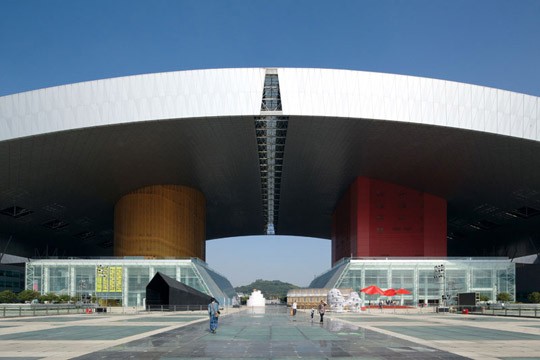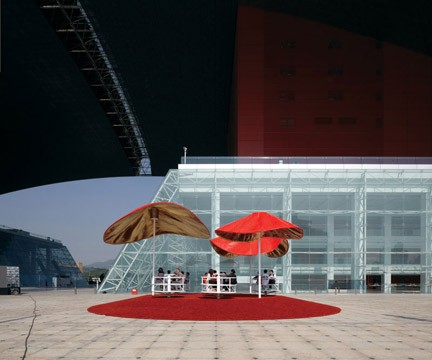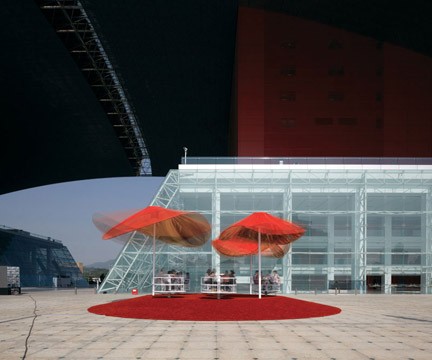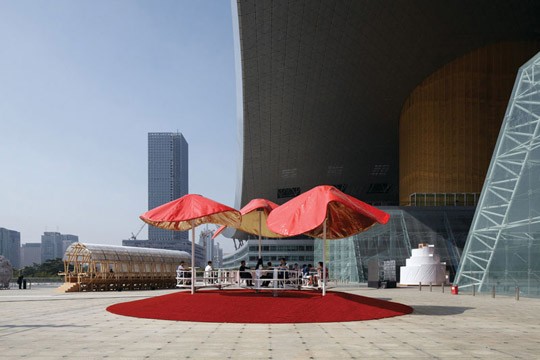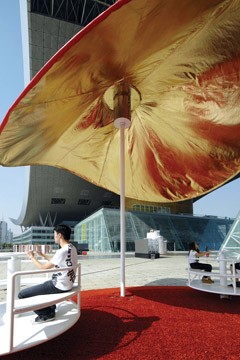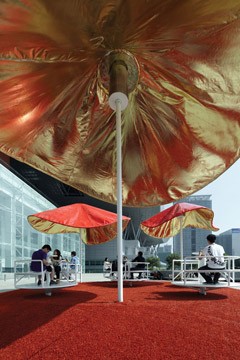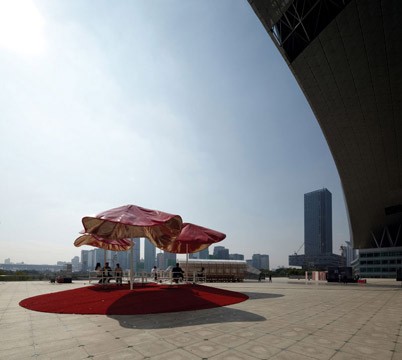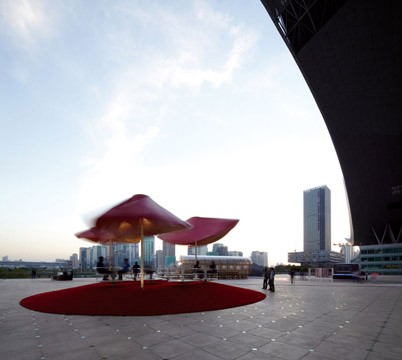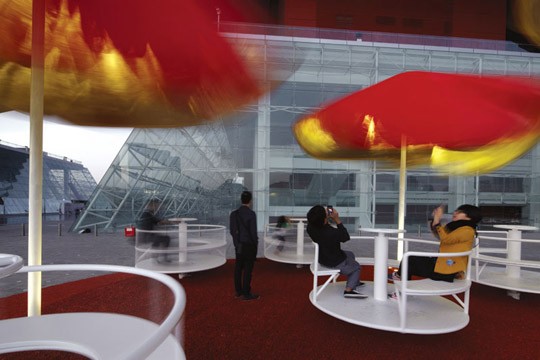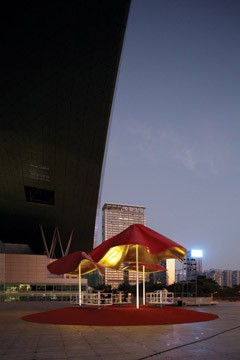Clavel Arquitectos
Pabellon Ultraligero Centrifugo
Shenzhen & Hong Kong biennale of urbanism\architecture 2011
Shenzhen Civic Square, China
Pabellon Ultraligero Centrifugo
Shenzhen & Hong Kong biennale of urbanism\architecture 2011
Shenzhen Civic Square, China
Text from the architects:
ENG: How much does your building weight? asked Buckminster Fuller and now again curator Terence Riley asks to the six teams invited to the Ultra Lightweight Village project.
Apart from the obvious answer we could conclude that any structure avoiding the effects of the gravity would weight nothing. So, can we make gravity disappear? Not, but we could compensate it.
Centrifugal Village is based in that concept. Three circles of waterproof light fabric of 7.8, 6.4 and 5.4 meter of diameter spin around their axis at only 1,5 turns per second. In the biggest one we can reach a cantilever of nearly 4 meters with an only 2 mm roof thickness. It is interesting to check how similar is the movement with the aquatic animal one. Thanks to the rotation the gravity apparently disappears and only aerodynamical forces shape the fabric. The soft waves produced on the surface create a smooth breeze that improves the thermical conditions behind during the hot and sunny days.
In a world where we charge our mobile phones wireless and we send information through the air, why should not dream about a not so far future in which our buildings are sustained by other forces, leaving gravity in a second line.
Public Space:
The pavilion creates a specific place for children in the huge square. Children can experiment with the centrifugal forces, generate electricity to open the structures and activate the lighting. The faster the children chairs rotate the more light the structure receives.
What happens later? :
Children chairs and their surrounding soft floor will be installed in other parts of the city, extending the life of the plays after the biennale. Electric materials will be used for industrial purposes. The red and gold fabric will be recycled in bags.
Centrifugal village / Bienal de Arquitectura de Shenzhen y Hong Kong 2011
ESP: ¿Cuánto pesa tu edificio?, preguntaba Buckminster Fuller. Ahora de nuevo el comisario de la Bienal Terence Riley hace la misma pregunta a los seis equipos invitados al proyecto “Ultra Lightweight Village”
A parte de la respuesta obvia podríamos concluir que cualquier estructura que no esté sometida a la fuerza de la gravedad tiene un peso igual a cero. ¿Podemos hacer desaparecer la fuerza de la gravedad? No, pero podemos tratar de compensarla.
El Pabellón ultraligero centrífugo se basa en ese concepto. Tres círculos de tela resistente al agua de 7.8, 6.4 y 5.4 metros de diámetro giran alrededor de su eje a tan solo 1,5 vueltas por segundo. En el más grande conseguimos un voladizo de casi cuatro con solo 2 mm de canto. Es interesante comprobar cuanto se parece el movimiento de la estructura al de un animal acuático. Esto ocurre debido a que gracias a la acción de la fuerza centrifuga conseguimos compensar los efectos de la gravedad en la tela y son solo fuerzas aerodinámicas las que configuran la forma de la estructura (al igual que serian hidrodinámicas en el caso de una medusa). Las suaves ondas que se generan en la superficie de la cubierta producen una suave brisa bajo ella que alivia las elevadas temperaturas en los días soleados.
En un mundo donde enviamos información a través del aire y donde cargamos nuestros teléfonos de manera inalámbrica, ¿porque no soñar en un futuro no muy lejano en el cual nuestros edificio se sustenten gracias a otras fuerzas, dejando la gravedad en un segundo plano?
El espacio público:
El pabellón crea en la inmensa plaza donde se ubica un espacio específico para los niños. Estos pueden experimentar la fuerza centrifuga haciendo rotar los juegos y a la vez activan el despliegue de las cubiertas y la intensidad de la iluminación en función de su esfuerzo.
¿Y qué pasa después?:
Los juegos de niños se instalaran en plazas de la ciudad, los componentes eléctricos se recuperaran para usos industriales y la tela de la cubierta se reconvertirá en bolsas.
